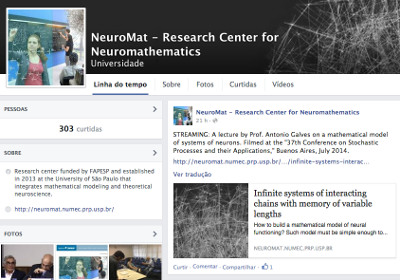
NeuroMat scientific dissemination to emphasize new media technologies
Jan 30, 2015
New technologies have been an especially significant means of disseminating results and outcomes of the FAPESP’s Research, Innovation and Dissemination Center for Neuromathematics (CEPID NeuroMat). The NeuroMat scientific dissemination team has been involved in media production in wiki frameworks —those related to the Wikimedia Foundation— and social media, especially through a NeuroMat page on Facebook. These media venues are part of what has been called “Web 2.0 services,” a set of sites that allow and encourage interaction and collaboration, thus potentially fostering the emergence of an active community around Neuromathematics and pertaining topics.
The NeuroMat scientific dissemination team has kept an ongoing flow of work on wiki platforms. This effort relates to NeuroMat's public commitment towards wiki scientific dissemination and pioneering Wikipedia Initiative. On July, 25, 2014, NeuroMat released "A call to duty: NeuroMat and the Wikipedia Initiative” in which it stated: "The general purposes of this initiative are to contribute to improving entries in the encyclopedia pertaining to Neuromathematics by making it easier for NeuroMat members and supporters to become involved in editing these entries as a means of scientific dissemination."
Since the launching of the Wikipedia Initiative, the NeuroMat scientific dissemination team has posted an increasing volume of pertaining scientific material on wiki platforms. On Wikipedia, the NeuroMat team has been involved in the writing of entries such as NeuroMat, Neuromathematics and Spike Sorting in the lusophone version of the electronic encyclopedia. On the Portuguese Wiktionary, it has created the entry on Neuromathematics. Pictures that pertain to NeuroMat or that were taken and published by members of the NeuroMat communication team have been systematically uploaded to the Wikimedia Commons, as long as there is no property-right infringement. Two news pieces related to NeuroMat were published at Wikinews: "Research center invests in 'wiki' scientific dissemination" and "Research center at the University of São Paulo launches open-source software to manage neuroscientific experimental data”. NeuroMat's investment in wiki scientific dissemination has been acknowledged by listing it as an organization that promotes open science on an Open Science Wikipedia entry.
The NeuroMat scientific dissemination team intends to expand the wiki scientific dissemination effort in 2015. In the first term of this year, an edit-a-thon —a gathering to work collectively on Wikipedia material— on topics pertaining to Neuromathematics might take place. At least two scientific publications on educational uses of Wikipedia that were produced within the context of NeuroMat’s effort on wiki scientific dissemination are expected to be released in 2015.
To learn more on Wikipedia and how it relates to Open Science, please refer to new, relevant material on Wikimedia Foundation technologies, here, in Portuguese.
NeuroMat’s Facebook page
 |
Since August 2014, NeuroMat has been on Facebook, attracting different audiences to news pertaining to neuroscience and mathematics, specialized articles and related information. In five months, NeuroMat’s page has gathered around 300 spontaneous members. A main 2015 goal of the NeuroMat communication team is to increase interaction among readers, researchers and general public. NeuroMat's main researcher, Prof. Antonio Galves, has said he encourages comments, posts and suggestions, in order to level up visibility of Neuromathematics.
The Facebook service provides interesting profile information on the followers of the NeuroMat page. Most users are male (61%), and such gender unbalance is especially worth highlighting, since in general male users correspond to 54% of Facebook users. The modal category of NeuroMat followers according to age ranges from 25 to 34 years old, which might be evidence that the page has been successful in attracting graduate students to its community. Most users of NeuroMat’s Facebook page are from Brazil (253 users), followed by USA (7) and India (4). With respect to users cities, São Paulo is the main one (104) and then Rio de Janeiro (33), Natal (14), Campinas (8) and Ribeirão Preto (7).
NeuroMat’s Facebook page most popular post has been on opportunities and positions. The posting of a position for working with architecture and software development at NeuroMat reached 471 people in 2014. Information pertaining to the release of new technologies, such as the Neuroscience Experiments System (NES), has also attracted wide interest —two NES-related news, for instance, have reached over 550 people.
To learn more on the NeuroMat social-media strategy, refer to this page.
This piece is part of NeuroMat's Newsletter #12. Read more here
Share on Twitter Share on Facebook| NeuroCineMat |
|---|
|
Featuring this week: |
| Newsletter |
|---|
|
Stay informed on our latest news! |
| Follow Us on Facebook |
|---|




